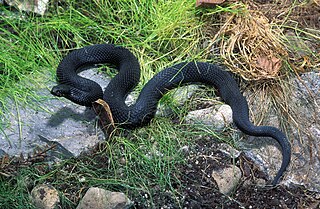
The Lacertidae are the family of the wall lizards, true lizards, or sometimes simply lacertas, which are native to Europe, Africa, and Asia. The group includes the genus Lacerta, which contains some of the most commonly seen lizard species in Europe. It is a diverse family with at least 300 species in 39 genera.

Laudakia is a genus of lizards, commonly known as Asian rock agamas, in the family Agamidae. The genus is endemic to Asia.

Eremias is a genus of lizards in the family Lacertidae, the wall lizards. They are native to Asia and southeastern Europe, where they live in desert and steppe regions.

Eumeces schneiderii, commonly known as Schneider's skink or the Berber skink, is a species of lizard in the family Scincidae. The species is endemic to Central Asia, Western Asia, and North Africa. There are five recognized subspecies.

Vipera nikolskii is a venomous viper species endemic to Ukraine, eastern Romania, and southwestern Russia. No subspecies are currently recognized.

Alexander Mikhailovich Nikolsky was a Russian and Ukrainian zoologist born in Astrakhan.

Alexander Strauch was a Russian naturalist, most notably a herpetologist.
Eremias andersoni is a species of lizard found in Iran's Kavir National Park.

Eremias pleskei, commonly known as Pleske's racerunner or the trans-Caucasian racerunner, is a species of lizard in the family Lacertidae. The species is native to the Armenian Plateau in Armenia, Azerbaijan, Iran, and Turkey.

Mediodactylus russowii, also known commonly as the grey thin-toed gecko, Russow's bent-toed gecko, and the Transcaspian bent-toed gecko, is a species of lizard in the family Gekkonidae. The species is native to Asia. There are two recognized subspecies.
Microgecko helenae, also known commonly as the banded dwarf gecko, Helen's banded dwarf gecko, Helen's tiny gecko, the Khuristan dwarf gecko, or the Khuzestan dwarf gecko, is a species of lizard in the family Gekkonidae. The species is endemic to western Iran.

Teratoscincus bedriagai, also known commonly as Bedraiga's wonder gecko or Bedriaga's plate-tailed gecko, is a small species of lizard in the family Sphaerodactylidae. The species is endemic to Central and Western Asia.

Eremias przewalskii, commonly known as the Gobi racerunner, is a species of lizard in the family Lacertidae. The species is endemic to Asia.
Heliobolus neumanni, also known commonly as Neumann's sand lizard, is a species of lizard in the family Lacertidae. The species is endemic to East Africa.
Mesalina ercolinii is a species of sand-dwelling lizard in the family Lacertidae. The species is endemic to Somalia.
Mesalina pasteuri, also known commonly as Pasteur's lizard, is a species of sand-dwelling lizard in the family Lacertidae. The species is endemic to North Africa.

Mesalina watsonana, also known commonly as the Persian long-tailed desert lizard, is a species of sand-dwelling lizard in the family Lacertidae. The species is endemic to Asia.

Pedioplanis namaquensis, known commonly as the Namaqua sand lizard or l'Érémias namaquois, is a species of lizard in the family Lacertidae. The species is endemic to Southern Africa.
Pseuderemias savagei is a species of lizard in the family Lacertidae. The species is endemic to Somalia.











